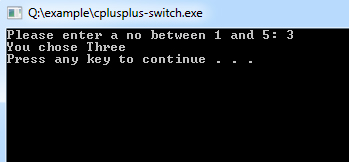The C++ switch Statement selects a code block to be executed from multiple code blocks based on the condition being evaluated once. This tutorial will teach you how to use the switch Statements in C++.
The standard format of the switch statement is:
Syntax:
switch(variable)
{
case 1:
//execute your code
break;
case n:
//execute your code
break;
default:
//execute your code
}After the end of each case block within a switch, it is necessary to insert a break statement because if programmers do not use the break statement, all blocks will execute continuously in every case, even after the case block is matched.
An example of a C++ program to demonstrate a switch statement:
Example:
#include <iostream>
using namespace std;
main()
{
int a;
cout << "Please enter a no between 1 and 5: " << endl; cin >> a;
switch(a)
{
case 1:
cout << "You chose One" << endl;
break;
case 2:
cout << "You chose Two" << endl;
break;
case 3:
cout << "You chose Three" << endl;
break;
case 4:
cout << "You chose Four" << endl;
break;
case 5:
cout << "You chose Five" << endl;
break;
default :
cout << "Invalid Choice. Enter a no between 1 and 5" << endl;
}
system("PAUSE");
}Program Output:

The default case will be executed when neither case evaluates to true, and the default statement does not require a break statement.